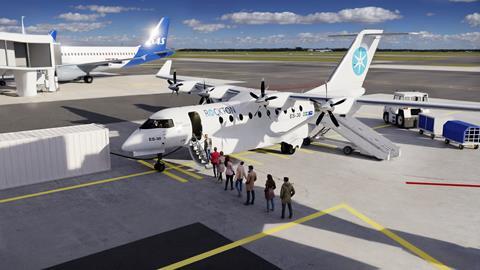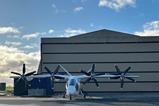Swedish ‘boutique lessor’ Rockton is eyeing an emerging market for low-carbon aviation as it completes its transition from an investor in traditional regional turboprops.
Rockton recently firmed up its interest in the developmental Heart Aerospace ES-30 hybrid-electric aircraft, converting a letter of intent (LoI) into 20 firm orders and 20 options.

Although the ES-30 is not scheduled to enter service until 2028, Rockton managing director Niklas Lund says the lessor decided to move early to “secure delivery positions going forward”.
“We think the ES-30 is a really interesting aircraft. It is probably as big as you can go in terms of payload given current [battery] technology, and 30 seats makes it an interesting entry point for legacy carriers and others,” says Lund.
He also highlights other benefits such as the potential for performance upgrades as battery technology improves and the ability for operators to open up new routes to under-served airports.
Additionally, Heart’s considered approach to the programme has given Rockton confidence. “They are very careful and thorough about how they go about the development,” he says.
Although Rockton does not yet have any customer commitments for the ES-30s, Lund is sure they will come.
“We have been in the regional sector for a lot of years and regional airlines are well aware they will be the first ones taking on the new technology. We are not concerned they will come on board.”
Rockton has previously invested in a broad range of regional types, including Saab 340s and 2000s, De Havilland Canada Q400 twin-turboprops and Bombardier CRJ1000 jets. However, in 2020 it took the decision to progressively divest that fleet and all that remains is a solitary Airbus A320.
Lund sees the push for the aviation sector to decarbonise as “an opportunity not a threat” and says Rockton will invest in assets – low-emission aircraft and those, such as firefighting types, for “climate change mitigation” – and provide growth capital to firms seeking to scale up zero-carbon technologies such as sustainable aviation fuel production.
It has already placed another LoI with an undisclosed manufacturer, says Lund, and continues to look for additional opportunities. However, “there is nothing else that has really made it yet”, he says, albeit it is “a dynamic changing market”.
To date, it has not invested in hydrogen-powered aircraft, viewing the path to certification as more challenging than with hybrid-electric designs and with more infrastructural hurdles to be solved.
Full-electric aircraft also do not yet offer the payload and range required to be an investable asset for the above 10-seat market, he contends, but could become more attractive as battery technology improves.
“If you look 10 years out some of the routes that will be served initially with hybrid aircraft could be served by full electric,” he says.
As new technology aircraft are introduced, lessors and OEMs will need to work together to support that process, Lund argues, ensuring the deployment of charging infrastructure and providing battery management services.
“It will be a package that we as the lessor together with the OEM support the airlines with,” he says.
Meanwhile, Rockton is still analysing how it will structure its investment in technology developers, says Lund, with a decision expected later this year.
In addition to fuel production, it is eyeing opportunities in software and in novel propulsion. But could that see it take a stake in Heart? “Potentially, yes,” he says.































